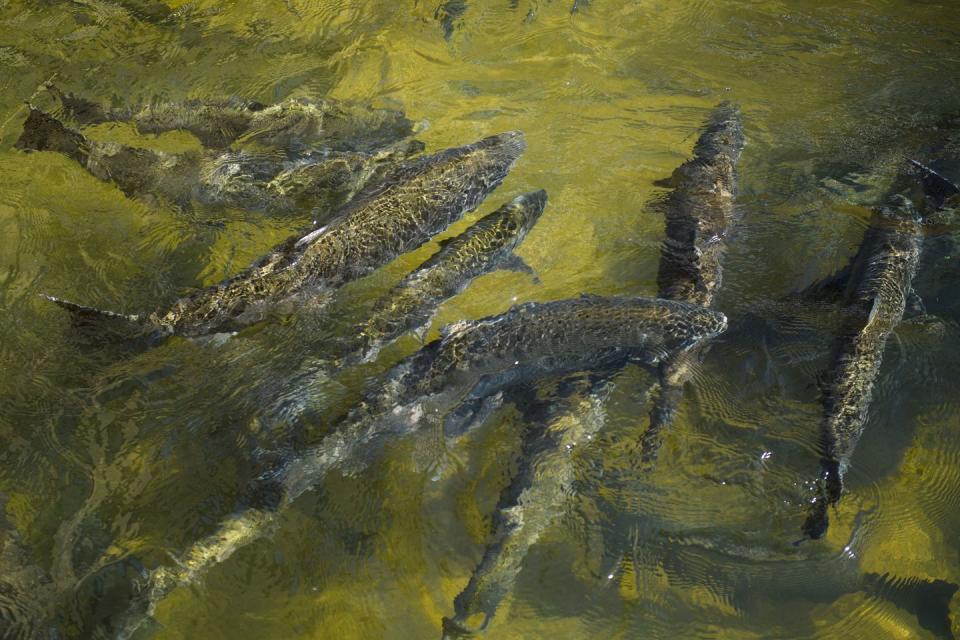Salmon Is About To Be Even More Expensive—And Nearly Impossible To Buy

Salmon may soon be very difficult to find, and may cost more than a pretty penny as a result.
The Pacific Fishery Management Council (PFMC) is recommending the cancellation of salmon fishing in California and a small portion of Oregon for the 2023-2024 season, which begins May 16.
The proposal is based on low population forecasts of Chinook salmon for Klamath River and Sacramento River.
Salmon is beloved around the world for its rich flavor and health benefits. But if you buy a lot of it, be warned that the fish will probably become even more of a delicacy this year, especially wild-caught salmon. The nutrient-dense fish will come at a steep price if salmon fishing is closed this year in California, which is likely.
Based on low population forecasts for Klamath River and Sacramento River Chinook salmon this fall, the Pacific Fishery Management Council (PFMC) is recommending the cancellation of salmon fishing in California and a small portion of Oregon for the 2023-2024 season, which begins May 16. The National Marine Fisheries Service (NMFS) must approve the proposal by May 15. This is very likely to happen, given they already took in-season actions to halt most salmon fishing south of Cape Falcon, Oregon, until then.
So what does this mean for your salmon dinners? For one, they’ll likely become more expensive.
“California is really good at growing food and providing…nutritionally valuable food to the American people—salmon is one of them,” said Robin Ehlke, the PFMC’s staff officer for salmon fishery management. “I think it will definitely be noticed that salmon’s not part of anybody’s meal plan.”
While there will be salmon fishing further north in Washington and parts of Oregon, the majority of wild-caught Chinook salmon on the West Coast comes from California, according to Ehlke.
With a low supply of wild-caught salmon, it's only natural that the prices of farm-raised might also increase. “A decline in fishing will increase prices and put a strain on people who make their living fishing,” said Bryan Boches, co-founder and CEO of Safe Catch. “We need to find the sustainable balance and invest in these ecosystems if we want future generations to enjoy catching salmon in California.”
California’s salmon industry has an annual value of $1.4 billion and supports 23,000 jobs, according to the Golden State Salmon Association.
A Decreasing Salmon Population

"Chinook salmon populations have been in a general decline," said Boches. "We have a much smaller population of Chinook salmon now than just 20 years ago."
This year, the forecast for Sacramento River Fall Chinook is less than 170,000, compared to a harvest of over 1 million fish in 1988 and 1995, according to a report from PFMC.
The last time California's salmon fishing season was canceled was in 2009. While there are several factors that determine a fluctuation of salmon populations, one of the biggest ones, according to Ehlke, is water—both lack of it and its quality.
“Salmon need cold, fresh, not fast-moving, but flowing water,” she said.
The water conditions have been greatly impacted by drought. "Low water flows during drought years is exacerbated by the diversion of water for farms and cities," said Boches. "Water was also being diverted to grow crops in the desert during a time of drought. That puts a tremendous strain on river systems."
After spawning in rivers, salmon head out to the ocean for a few years before returning, so any environmental factors from three years ago are now affecting the low returns and population forecasts, according to a press release. Given past patterns of drought and rainfall, salmon populations should bounce back—and return to plates.
"With the well above average rainfall we’ve had this year in California, hopefully that will help the overall health of fresh waterways in the state. However, these are delicate ecosystems, and sometimes too much water can also negatively affect salmon eggs and hatchlings," said Boches.
While salmon are resilient, Ehlke said it wouldn’t be surprising for the numbers to be low again next year, as it will probably take a year or two for the population to recover.
Increasing hatchery production is one way to increase population, but the survival of those fish is reliant on healthy water, according to Ehlke. Currently, there's an effort to remove four Klamath River dams—the first of which would be dismantled this summer. Ehlke said this exciting development has been in the works for decades and will provide flowing water and habitat for salmon.
"As long as society comes together to protect the purity of our waterways and to utilize and monitor responsible, sustainable fishing practices, we can have a thriving ecosystem," said Boches.
You Might Also Like


